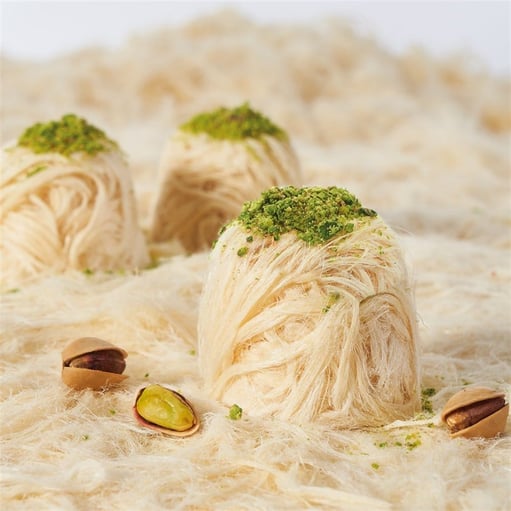Pişmaniye: The Fluffy Delight of Turkish Sweets
When we talk about Turkish desserts, most people think of baklava or Turkish delight. But nestled among the more famous treats is a unique, delicate confection that melts in your mouth and lingers in memory — Pişmaniye.
🌾 What Is Pişmaniye?
Pişmaniye (pronounced pish-mahn-yee-ye) is a traditional Turkish sweet made from sugar and flour, crafted into light, airy strands resembling cotton candy or angel hair. Despite its visual similarity to cotton candy, its texture and preparation are quite different. It's not spun sugar, but rather a delicate weave of flour-roasted butter and sugar syrup, hand-pulled into fine threads.
It’s often referred to as:
-
Turkish floss halva
-
Tel helva
-
Keshmesh (in some regions of Iran)
🥄 How Is It Made?
The preparation of pişmaniye is both an art and a performance. Here's a simplified overview:
-
Roast the flour in butter or oil until golden.
-
Boil sugar and water into a thick syrup, similar to caramel.
-
The roasted flour and the sugar syrup are then kneaded together — a challenging process.
-
Through repeated pulling, folding, and twisting, the mass is stretched into hundreds of silky threads.
This pulling technique is very similar to how Chinese Dragon’s Beard Candy or Iranian pashmak is made, though each has its unique touch.
🧁 Taste and Texture
Pişmaniye has a light, fibrous, melt-in-the-mouth texture with a nutty, buttery flavor. It often comes in small round bundles, sometimes topped or filled with:
-
Pistachios
-
Hazelnuts
-
Cocoa or vanilla flavoring
The moment you take a bite, it dissolves almost instantly, leaving a satisfying, subtly sweet aftertaste.
🧳 A Sweet With a Sense of Humor?
The word “pişmaniye” comes from the Turkish word “pişman”, meaning regret — as in, "regretfully sweet". There’s even a saying:
“Bir pişmaniye, bir pişmanlık” – “One pişmaniye, one regret.”
The idea? You’ll regret it if you don’t eat more!
🌍 Origins & Cultural Significance
Pişmaniye is believed to have originated in Kocaeli (İzmit) in northwestern Turkey and has been made there since the 15th century.
Today, it's commonly found in:
-
Turkish sweet shops
-
Airport gift boxes
-
Traditional celebrations and holidays
It’s also popular in Middle Eastern and Balkan cuisines, with variations in Iran, Armenia, and even parts of India.
🎁 A Popular Gift
Because it’s lightweight and keeps well when packaged, pişmaniye is a popular souvenir. You’ll often find beautifully wrapped boxes at airports or gift shops labeled "Authentic Turkish Pişmaniye."
🍽️ How to Enjoy It
-
With Turkish tea or coffee
-
As an after-meal dessert
-
Shared with guests or during celebrations
Pro tip: don’t touch it with wet hands — it will melt instantly!
🧡 Final Thoughts
Pişmaniye is more than a dessert — it’s a piece of Turkish culinary heritage. With its playful texture, gentle sweetness, and traditional charm, it’s a treat that brings joy and surprise with every bite.
If you ever find yourself in a Turkish market or browsing for exotic sweets online, don’t hesitate to try pişmaniye. You may just regret not having done it sooner.
